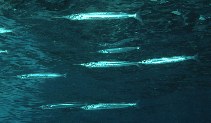| Family: |
Hemiramphidae (Halfbeaks) |
| Max. size: |
39.8 cm SL (male/unsexed) |
| Environment: |
pelagic-neritic; brackish; marine; depth range 0 - 20 m |
| Distribution: |
Southwest Pacific: eastern Australia from Moreton Bay, Queensland to Eden, New South Wales, including Lord Howe and Norfolk Islands. |
| Diagnosis: |
Dorsal spines (total): 0-0; Dorsal soft rays (total): 15-17; Anal spines: 0-0; Anal soft rays: 17-20; Vertebrae: 56-58. Preorbital canal with a posterior branch. Relatively longer jaws, especially at larger sizes. Gill rakers usually 34 or more in the first arch and usually 27 or more on the second arch. |
| Biology: |
Found in sheltered bays, clear coastal waters and sometimes in estuaries (Ref. 27012). Generally herbivorous. Feed mainly on seagrasses and algal filaments (Ref. 26551, 27013). Eastern sea garfish also consume a high proportion of crustaceans (Ref. 27013). A schooling fish, found generally near the surface at night and close to the sea floor over seagrass beds during the day (Ref. 6390). They are being preyed upon by mulloway (Argyrosomus hololepidotus) and tailor (Pomatomus saltatrix), as well as coastal water birds. No studies have been reported on the spawning of this species (Ref. 6390). |
| IUCN Red List Status: |
Not Evaluated (N.E.) Ref. (130435)
|
| Threat to humans: |
harmless |
Source and more info: www.fishbase.org. For personal, classroom, and other internal use only. Not for publication.

